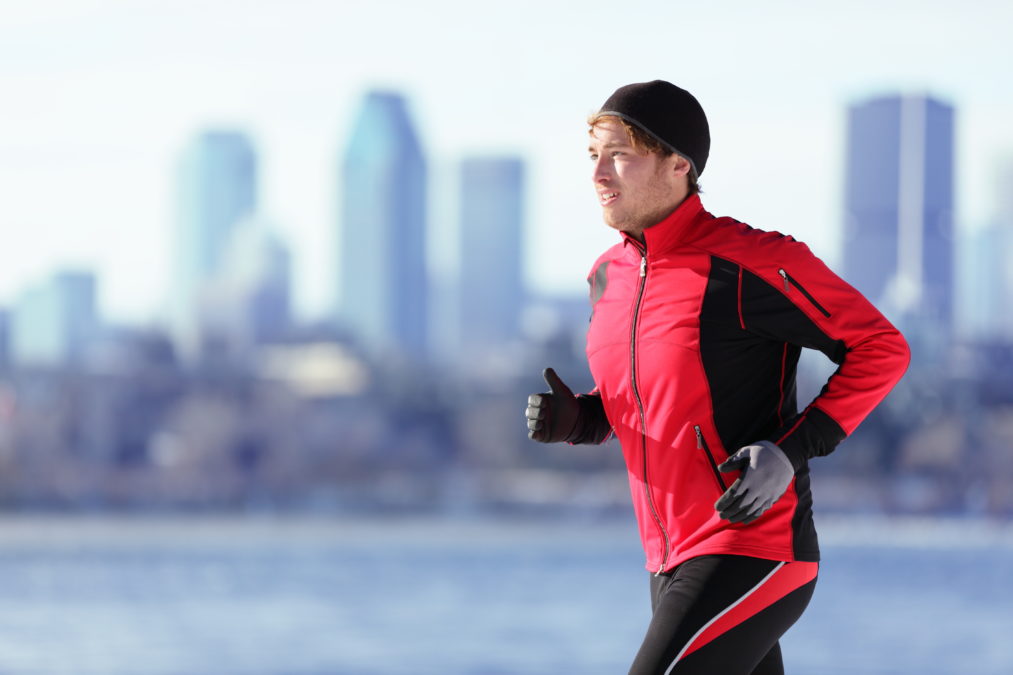
As the saying goes, ‘There’s no such thing as bad weather, only unsuitable clothing’ – the perfect motto for this article. Because anyone who wants to go running, cycling or doing any other sport outside in the winter must dress appropriately. pjuractive has done a little research on things athletes should bear in mind when choosing sports clothing in winter. This doesn’t just cover terms such as thermal trousers and thermal underwear, but we also look at the phenomenon known as the wind chill effect.
Tips to help you choose the best winter sport clothes for working out
Tip 1: Your winter sports clothes must be reflective!
During the winter, it’s usually still dark in the morning when we leave the house, and it’s already gone dark again when we get home in the evening. So if we work out outside in the dark, we have to make sure we can be seen. It’s particularly vital on the roads. Your best bet therefore is to wear bright, visible and reflective sports clothing in winter – and not just in winter in fact. This is something you should always bear in mind when you’re working out outdoors in the dark or during twilight hours! To be on the safe side and make sure you’re always seen, a headlamp may also be a good idea. Not only will it help light the path ahead, but it can also ensure other people see you, too.
Tip 2: The right footwear
It is particularly important to wear the right footwear, especially when there’s rain, snow or black ice to contend with. Shoes you use to exercise outdoors in winter must have a sole with good grip. When buying footwear, you should also ensure the shoes provide good support. The perfect shoe for working out outdoors in cold temperatures should also be water-repellent.
Tip 3: Lots is not always good. But neither is too little.
Some people think that working out will make them warm anyway, and others think it’s better to wear too much than not enough. Unfortunately, neither of these is a sensible approach. If you wear too much you start sweating relatively quickly, and then there can even be a build-up of heat. If you don’t have enough on, then many athletes try to compensate by going faster. This is far from a good idea, as you are much better reducing your speed rather than running too fast, particularly in cold temperatures. The so-called wind chill effect usually causes problems when choosing winter sports clothes. We explain what it is exactly in our next tip.
Tip 4: Actual and perceived temperature – the wind chill effect
The wind chill effect is all about the actual air temperature and the temperature it feels like. These two temperatures are different at cold temperatures. As athletes, when you run or are active outdoors, this creates a relative wind as it were. And the wind chill effect is dependent on precisely this wind speed. Since this effect is only found at cold temperatures, it is only calculated at temperature below 10°C. If it is 5°C outside, then this feels like 2.7°C at 10 km/h and 1.7°C at 15 km/h. This is just an example to illustrate the principle. So when it comes to winter sports clothes, it’s not necessarily the actual prevailing temperature that you need to bear in mind.
Tip 5: The onion look
Wearing several layers on top of each other – known as the onion look – is a good approach to dressing for an outdoor workout. This means that athletes should wear several items of clothing one on top of the other. Not only is it practical as it allows you to take individual pieces of clothing off again if you start to get too warm, but it’s really all about the layers of air that are created between the individual items of clothing. These layers of air function like insulation and can therefore have a warming effect. You just need to make sure you choose clothes that are comfortable and are not restrictive. The first layer should be thermal underwear. Thermal underwear is available in a variety of styles, for both men and women.
Tip 6: Hat and gloves
If your outdoor run or workout session lasts longer than an hour, you should definitely think about wearing a hat to cover your head and ears and gloves for your hands. Your body loses most heat from the head, which is why it’s important to wear a hat to create a barrier. And since the hands can be particularly susceptible to the cold, it’s important to protect them with gloves, too.
Tip 7: Look out for the materials of your winter sports clothing!
As well as the onion look, when it comes to what clothes athletes should wear in cold temperatures it’s important to choose the right materials, too. In winter, you should only choose sports clothes made from a functional fabric. So-called functional textiles are composed of natural fibers, synthetic fibers or a combination of the two. These specialist sport clothes for winter are usually windproof, waterproof, thermoregulating, and – crucially – breathable. They ensure that, despite wearing multiple layers, the moisture and heat generated by the body are released to the outside without this having a cooling effect. When choosing the outer layer which you wear when working out outdoors – the jacket – you should make sure it is windproof and rainproof. To prevent excessive heat loss in the lower body region, you should go for thermal trousers. These will also keep your legs warm and are breathable, too. Thermal trousers come in a vast range of designs and styles.
Follow these tips for winter sports clothes and you too will be able to work out in cold temperatures outdoors. With the right clothing, cold temperatures and bad weather conditions won’t bother you – and you’ll stay fit all through the winter, too! Enjoy 🙂